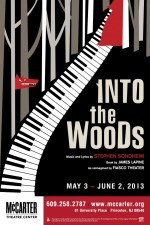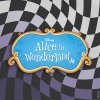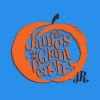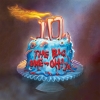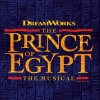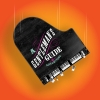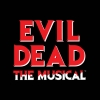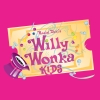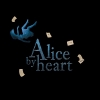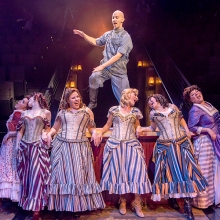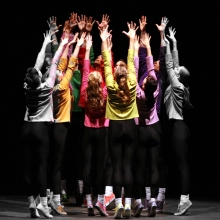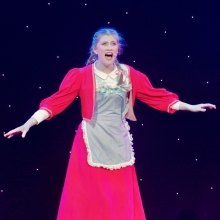Filichia Features: Into the Woods: It Takes Ten
Filichia Features: Into the Woods: It Takes Ten
Can you find 19 talented performers to play all the roles in Into the Woods?
That seems to be an order as tall as the second-act Giant. But if you take some tips from the most inaccurately named Fiasco Theater, you can stage the Stephen Sondheim-James Lapine masterpiece with only 10 people.
Don’t believe it? Then get thee to the Berlind Theatre in Princeton, New Jersey by Sunday, June 9. You’ll see that Fiasco is achieving the seemingly impossible.
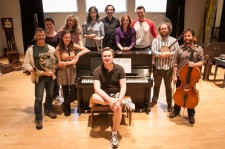
Technically, directors Noah Brody and Ben Steinfeld could have even done the show with nine performers. All they had to do was go with the authors’ original decision in 1987 to have Milky White, the cow that belongs to Jack (of future beanstalk fame), be represented in plastic. But they made a different decision – and not the one that enhanced the 2002 Broadway revival (when Chad Kimball played the beast, but was totally encased in a costume that made him appear to be an overgrown Shar Pei).
Brody and Steinfeld decided not to have Andy Grotelueschen covered at all or walk on all fours. Grotelueschen instead stands upright in white shirt (although it’s off-white rather than bright) and jeans. Some purists may object, but the actor and directors get plenty of laughs, starting from the moment that Jack encircles Milky White’s neck with a cow bell on a ribbon.
His reactions are quite human. When Milky hears that he’s to be sold, he winces -- although he reserves his greatest winces for the (many) times that Jack says something stupid or does something even more senseless. Milky White is, however, resigned to his fate of being sold to the Baker, and is a good soldier about it – which makes theatergoers feel for him in a way that no audience before ever has.
Several scenes later when boy and pet next see each other, Milky White gives Jack enthusiastic “cummere and embrace me” gestures with both hands. (The lad is only too happy to rush over and hug.) And when Milky White must go to Cow Heaven, he first grabs his left arm in pain – suggesting an impending heart attack. Once again, the audience expresses sympathy. Who expected that?
Finally, we see Milky White eat the cape -- and the way that Grotelueschen accomplishes this is to simply put the cape under his shirt, which protrudes in a lump and conveys that he “ate” it.
So Milky White is an added role. Who’s been sacrificed? Funny – the character whom Sondheim and Lapine waited to eliminate in Act Two doesn’t get a moment of stage time here: Narrator. Instead of one man’s guiding us through the story, Brody and Steinfeld have shared the wealth among their 10 actors – which includes themselves.
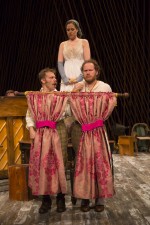
Brody and Grotelueschen play both Cinderella’s Stepsisters and the two Princes. The former delight as soon as they enter, thanks to Whitney Locher’s coup de théâtre costuming decision. Take a curtain rod and from it hang two curtains that are bisected with sash ties. Have Brody and Grotelueschen each take an end of the rod, place the entire apparatus under their chins, and presto! They suddenly appear to be clad in dresses and have become the stepsisters.
When they’re the princes, they prance on hobby horses. Fine and obvious, you say. Even that they hand their horses to front-row spectators may not strike you as terribly innovative. But Grotelueschen, as Rapunzel’s Prince, had a moment of genius. When he trotted on stage and said, “Ah, there you are, good brother,” he kept moving around on his hobby horse, back and forth, up and down. How smart! How many times have we seen movies in which a horseman arrives at his destination, begins talking, but the horse continues to move about?
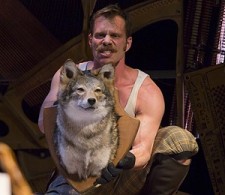
When time comes for The Wolf to enter, Brody peeks out from behind the one upright piano (on which Matt Castle provides most of the music). The actor then picks up a mounted wolf’s head that looks as if it just came from the taxidermist’s and puts it in front of his face. Soon after he begins “Hello, Little Girl” (which Castle plays in a much more bluesy fashion), he tosses the wolf’s head to another cast member, and jumps onto the floor on all fours and pursues Little Red Ridinghood.
Little Red and Rapunzel are played by Emily Young. Usually, there’s a good decade’s difference in their ages, but who says that Little Red must be young? “Little” and “young,” after all, are not synonymous. Think how old Granny is always shown to be; a case can be made that if Little Red’s grandmother is already that old, then Little Red is already quite the young woman. That’s how Young (!) plays her -- at least until her cape is stolen; then she cries very much like a little girl).
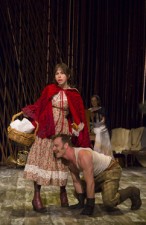
When Little Red enters Granny’s house, the edifice is simply suggested by a sheet; the two meet behind it in shadow play. That mounted wolf’s head returns, as an actor places it in front of Granny’s head, so the silhouette we see now is one of a wolf’s head on a grandmother’s body. Clever.
The Baker pretends to slice the sheet, and from under it come both women. When Young sings “I Know Things Now,” she first shoves her riding hood behind her and creates the illusion of a superhero’s cape. The Wonder Woman image is complete once she resolutely stands with legs apart and arms akimbo.
On the other hand, Jack’s Mother, ably portrayed by Liz Hayes, is much younger than the squat, aged woman we’ve seen in so many productions. Her grounded take seems more contemporary – no, make that timeless – and allows her to make a nice contrast with Cinderella’s Stepmother, whom she also plays. Note that as soon as Jack’s Mother dies (in what seems to be a more murderously motivated attack by the Steward), Hayes immediately puts on a new hat and becomes the bane of Cinderella’s existence.
Three actors play single roles: Steinfeld is The Baker, Jessie Austrian his Wife and Jennifer Mudge is The Witch, who wears a mask not unlike the one The Phantom sports. When the time comes for her transformation, Mudge goes behind the upright and quickly sheds her mask and dull duds under which, we learn, she’s wearing a sexy black nighty. Mudge expresses unmitigated delight until she discovers that she’s lost her powers – and mouths a four-letter word that still isn’t often said in polite company.
When the musical was originally produced, some were surprised that the house for The Baker and his Wife should have been in the center, because they were the main characters. Here, there’s no attempt to put anyone in a gingerbread-ish house; a piano, a couple of tables and not many more chairs are all that grace the stage. Most of the chairs are lined around the stage’s perimeter, so that when characters aren’t performing, they sit.
The less-is-more format continues throughout. A long yellow scarf stands in for Rapunzel’s hair. A feather duster with hidden handle is the stolen hen. A grandfather clock in the corner provides the chimes struck at each midnight. The birds that visit Cinderella (and later torment her two sisters) are simply pieces of note paper that are folded over once and “flown” around in actors’ hands; no detailed attempt is made to have them resemble birds. We see everything but the proverbial kitchen sink, probably because one wasn’t around.
As for The Giant, a big bass drum is hit to establish each of her steps, a megaphone gives her voice the right timbre and tipped-over furniture is enough to establish that she’s arrived.
I’ll concede that those who have never seen or listened to Into the Woods might be confused by this deconstruction. And yet, I must also report that in 13 previous visits to the show in the last quarter-century, I’ve never seen an audience chuckle and laugh more than this Berlind audience. Granted, this may be because most of the theatergoers had already seen the show. But it could also be because Fiasco Theater really got into Into the Woods.

You may e-mail Peter at pfilichia@aol.com. Check out his weekly column each Tuesday at www.masterworksbroadway.com and each Friday at www.kritzerland.com. His upcoming book, Strippers, Showgirls, and Sharks – a Very Opinionated History of the Broadway Musicals That Did Not Win the Tony Award is now available for pre-order at www.amazon.com.
Share
Callboard
-
Shake and shimmy it with the #Hairspray20Challenge! Join MTI and Broadway Media in celebrating 20 years of #Hairspray. Duet this here or find us on TikTok! Special thanks to @broadwaymedia and @jammyprod. Choreography Guides are a licensor official resource that provides step-by-step instruction from Broadway and professional choreographers for your productions! Visit @broadwaymedia to learn more. #mtishows #youcantstopthebeat #hairspraymusical #goodmorningbaltimore
View on Instagram
